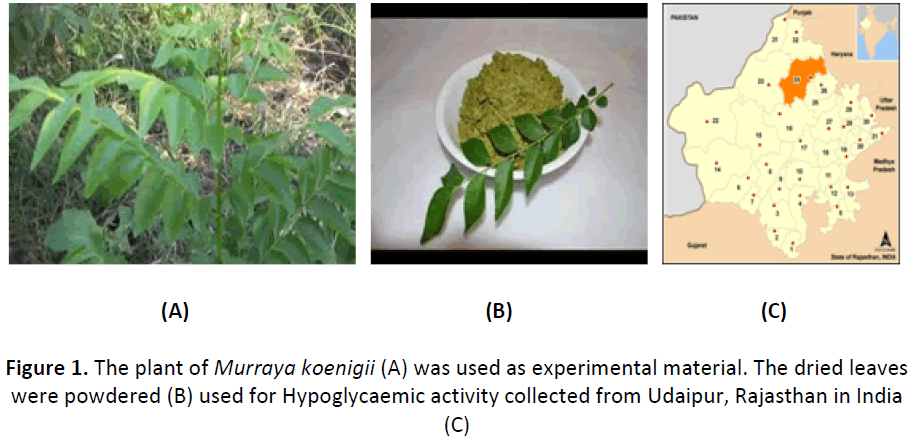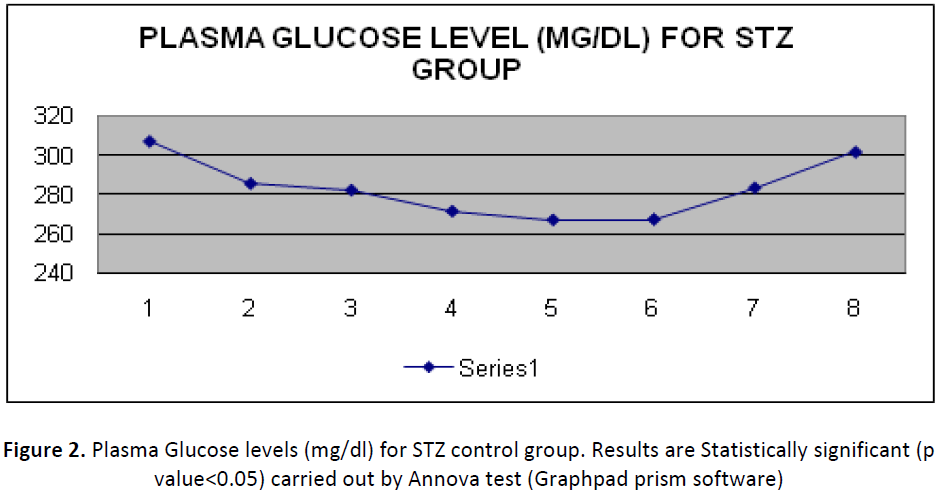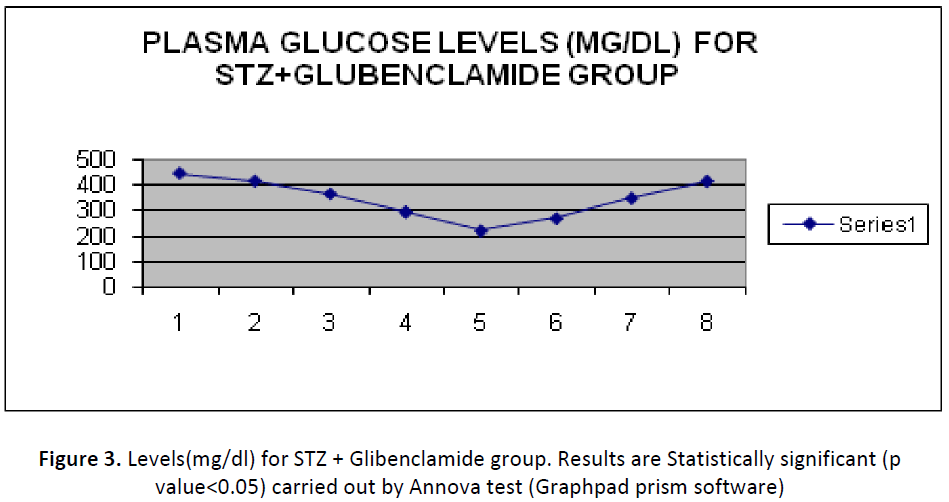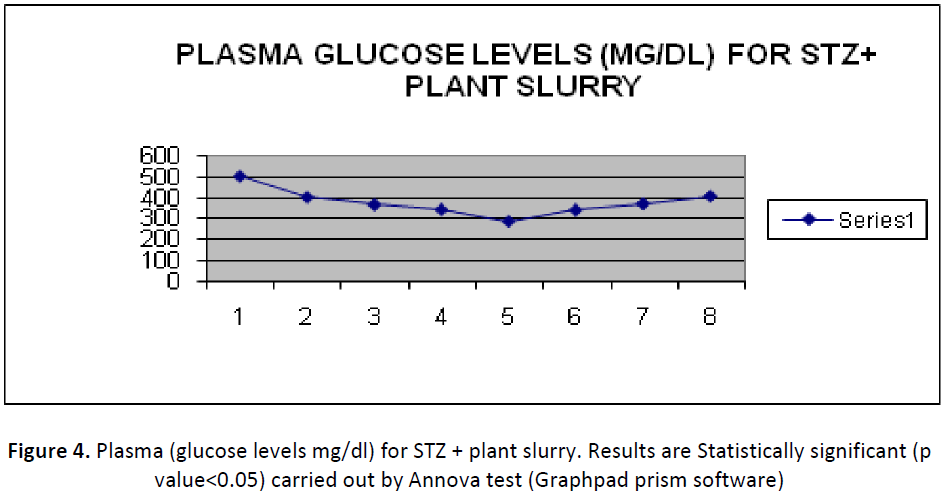ISSN : 2348-9502
American Journal of Ethnomedicine
Hypoglycemic Activity of Murraya koenigii (Meethaneem) Leaves Collected from Udaipur, Rajasthan (India)
Haffkine Institute for Training, Research and Testing, Parel Mumbai 400012, India
Abstract
Introduction: Medicinal plants are being used in the traditional systems of medicine in many parts of the world, especially in rural communities for diverse types of ailments. Diabetes mellitus is one of the extreme common chronic diseases. Many synthetic drugs are used to control hyperglycaemia. However, due to host resistance and other adverse effects of these compounds this becomes essential to find out the natural source to combat with the disease.
Objective: The main objective of current study was to evaluate the hypoglycaemic activity of Murraya koenigii (Meethaneem; Rutaceae).
Method: Leaves collected from Udaipur, Rajasthan region in the month of October were evaluated for hypoglycemic activity. Male wistar rat was used as experimental animal. Diabetes was induced by an intra-peritoneal (i.p.) injection of Streptozotocin. Animals with blood glucose>200mg % were selected and used for the study. Single dose of aqueous slurry of dried leaves powder (250mg/Kg) of Murraya koenigii were administered to selected animals for evaluation.
Result: Murraya koenigii (Meethaneem) leaves slurry exhibited a significant hypoglycaemic activity on fourth hours of dosing, which reduced the glucose level up to 56% that is more effective than standard drug Glibenclamide (49%) and statistically significant (<0.05).
Conclusion: The novelty of the work done is embedded in collection of data of hypoglycaemic activity of Murraya koenigii (Meethaneem) leaves collected from Udaipur, Rajasthan, India in the month of October, which showed a remarkable potential. The results was comparable to standard compound (Glibenclamide).
Keywords
Murraya koenigii, Hypoglycaemic, Leaves.
INTRODUCTION
Plants have been the major source of drugs in Indian system of medicine and other ancient systems in the world. Earliest description of curative properties of medicinal plants is found in Rig-Veda (2500 -1800 BC). Charka Samhita and Sushruta Samhita give extensive narration on various medicinal herbs [1-4]. Now in current scenario the use of plant derived natural products in drugs preparations becomes a drift, therefore there is a need to date information on the properties, uses, efficacy, safety of medicinal plant products [5,6]. Diabetes mellitus is one of the most common chronic disease in the whole world. It is a complex, multifactorial disease, which affects the quality, quantity, and style of a person’s life. The fact confirmed by report from the World Health Organization (WHO) shows that India has the largest number of diabetic patients in the world [7]. Many drugs have been used to control hyperglycaemia, but these synthetic agents produce some serious side effects and are relatively costly for developing countries [8]. The toxicity of oral anti-diabetic agents varies widely in clinical expressions, strictness, and treatment [9]. In the natural system of medicine, many plants have been appealed to be useful for the treatment of hyperglycaemia. The dependence of large rural population on medicinal plants for treatment of diabetes is because of its convenience and affordability [10]. Additionally, after the approval made by WHO on diabetes mellitus, the recognition of antidiabetic agent derived from plants become more popular and important [11]. Many plant sps like Dilleniaindica [12], Trigonella foenumgracum and Amaranthussps [13] etc. have been evaluated for their hypoglycaemic action. Hyperglycaemia is a pathological condition associated with prediabetes and diabetes. The occurrence of prediabetes and diabetes is increasing and carry out great problem on healthcare worldwide. Patients with prediabetes and diabetes have significantly increased risk for cardiovascular diseases and other problems. Presently, management of hyperglycaemia includes pharmacological involvements, physical exercise, and change of life style and diet. Food supplements have increasingly become better alternatives to treat hyper-glycaemia. In a review regarding anti- diabetic herb, five commonly used food supplements with hypoglycaemic effects, including Emblica officinalis (gooseberry), fenugreek, green tea, Momordica charantia (bitter melon) and cinnamon were considered [14]. Fenugreek and Emblica officinalis showed the most consistency in lowering fasting blood sugar (FBS) or glycated hemoglobin (HbA1c) levels in diabetic patients. The hypoglycaemic effects of cinnamon and Momordica charantia were seen the best. However, green tea exhibited inadequate benefits in reducing FBS [14]. In another report, the consumption of cinnamon is connected with a statistically significant decrease in levels of fasting plasma glucose [15]. Diabetic model can be generated using known diabetic inducers such as Alloxan or Streptozotocin (STZ). The cytotoxic action of both diabetogenic agents is mediated by reactive oxygen species, however the source of their generation is diverse in the case of Alloxan and Streptozotocin [16]. In the present study, we have used Streptozotocin as diabetogenic agent. Streptozotocin enters the β cell via a glucose transporter (GLUT2) and causes DNA alkylation. DNA damage induces activation of poly ADP-ribosylation, a process that is important for the diabetogenicity. Furthermore Streptozotocin liberates toxic amounts of nitric oxide that prevents aconitase activity and participates in DNA damage. As a result of the Streptozotocin action, β cells undergo the destruction by necrosis [17,18].
Among several medicinally important plant, Murraya koenigii (Meethaneem) has an significant place for treatment of nausea, vomiting, stomachache, digestion, etc. Murraya koenigii (Family: Rutacea) is a small tree. Curry leaf is found almost throughout India up to an altitude of 1500 meters. It is much cultivated for its aromatic leaves [19]. Meethaneem plant (experimental plant) extracts (methanolic and aqueous) have been evaluated for its hypoglycaemic activity in Streptozotocin induced diabetic rat model [20], so it was highly essential to compare the data of hypoglycaemic activity of aqueous slurry of leaves powder with previous results.
Hence, the main goal of the present study to find out the better source to manage the hyper glycaemia. We have evaluated leaves powder of the experimental plant (Murraya koenigii) collected from Udaipur, Rajasthan region in the month of October for its hypoglycaemic action in Streptozotocin induced diabetes model. In the described study, the active principal to manage the hyperglycaemia seems more potent in Murraya koenigii leaves collected from Udaipur, Rajasthan in the month of October.
The novelty and rational of the study is to search the easily available, better source for management of hyper glycaemia , data collection and the effect of seasonal and geographical variation on the potency of medicinal plants. Thus keeping all the facts, in the present study we have selected Murraya koenigii as an experimental plant for its hypoglycaemic activity.
MATERIALS AND METHODS
All experiments were in agreement with ethical guidelines for investigations of experimental plant in conscious animal. Research protocol was approved by the Institutional Animal Ethics Committee.
Collection of plant material
The Plant material (Leaves) of Murraya koenigii was collected from Udaipur, Rajasthan (27° 42' N, 75° 33' E) in the month of October. Plant Material was identified by Botanist, Haffkine Institute and preserve for further specimen. Collected leaves were shade dried and powdered.
Procurement of animals
Male Wistar rats weighing (190–200 g) were obtained. They were housed in ventilated cages and fed with a normal pellet diet (Hindustan lever, Mumbai, India) and water ad libitum. All experiments were in agreement with ethical guidelines for investigations of experimental plant in conscious animal. Research protocol was approved by the Animal Ethics Committee (CPCSEA registration no. CPCSEA/315).
Induction of diabetes
Glibenclamide (Daonil 5 mg manufactured by Aventis Pharma Ltd.) a well-known anti-diabetic sulphonylurea was used in the present research work as the known hypoglycaemic agent for efficacy study (purchased from the market). Diabetes was induced by an intra-peritoneal (i.p.) injection of Streptozotocin. The animals were carefully monitored every day and weighed. No significant changes were noticed in the behaviour and general health of the animal after administration of Streptozotocin. After three days, rats with marked hyper-glycaemia (blood glucose> 200mg %) were selected and used for the study. 2ml of distilled water was administered to group 1. Glibenclamide (500μg/Kg) was administered to group II. Single dose of aqueous slurry of leaves powder of experimental plant (250mg/Kg) was given to selected animals (group III). The blood samples were collected at 0 hour, 1 hour,, 2 hour,, 3 hour,, 4 hour,5 hour,, 6 hour,, 24 hour, after single dosing in clean and pre-heparinised vials. Each vial was labelled properly with the identification number corresponding to the animal and the plasma samples were processed for estimation of plasma glucose.
Experimental design
Procedure
The wistar male rats weighing 190- 200 g were obtained from Bharat Serum pvt. Ltd. All the animals were kept in an environmentally controlled room with 12hourslight/12 hours dark cycle. Water was ad libitum and fed standard rat diet. The animals were fasted overnight and diabetes was induced by a single intra-peritoneal injection of freshly prepared solution of Streptozotocin (50 mg/kg body weight) dissolved in 0.2 ml of 0.1M cold citrate buffer pH 4.5 (Prakasam et al., 2008) . The animals were allowed to drink 5% glucose solution overnight to overcome drug induced hypoglycaemia (Bhandari et al, 2008). STZ- injected animal’s exhibit massive glycosuria and hyper-glycaemia (Prakasam et al 2008). After three days animals with marked hyperglycaemia (blood glucose level above 200mg %) were selected and used for the evaluation of hypoglycaemia (Bhandari et al, 2008).
Statistical analysis
Results were presented as mean ± SEM. Statistical analysis of all the data obtained was evaluated using one-way ANOVA. The differences were considered significant at P ≤ 0.05.
RESULTS
Murraya koenigii Linn. (Rutaceae) is commonly known as Curry patta and is widely used as condiment and spice in India. It has been reported that feeding different doses of M. koenigii leaves to alloxan induced diabetic rats play a role in control the mild to moderate diabetes [21] Kesari et al., 2007 have examined the effect of 1 month oral administration of Murraya koenigii aqueous leaves extract in normal and STZ induced severe diabetic rats, in their study they observed a decrease of 75% in urine sugar [22]. In another experiment Kesari et al., 2005 have observed the maximum fall of 14.68% in normal and 27.96% blood glucose in mild diabetic after 4 h of oral administration of 300 mg/kg. In both cases plant leaves were collected from Allahabad (U.P.) [23]. This shows the plant leaves collected from Udaipur Rajasthan in the month of October is better source to eliminate the hyperglycaemia. Asin the present study, Murraya koenigii (Meethaneem) leaves collected from Udaipur, Rajasthan aqueous slurry exhibited a statistically significant (p value<0.05) hypoglycaemic activity on fourth hour of dosing (250mg/Kg) which reduced the glucose level up to 56% that is more effective than standard drug Glibenclamide (49%). (Table 1-3; Figure 2-4), thus meethaneem plant leaves, collected from Udaipur, Rajasthan in the month of October can be used to control hyperglycaemia in the form of aqueous slurry. This result is showing an enthusiasm in finding a source for hyperglycaemia management and more better than previous findings.
Table 1: Plasma Glucose levels (mg/dl) for STZ control group. Results are Statistically significant (p value<0.05) carried out by Annova test (Graphpad prism software)
| S. No. | Animal no | 0 hr | 1 | 2 | 3 | 4 | 5 | 6 | 24 |
|---|---|---|---|---|---|---|---|---|---|
| 1. | 1st | 302.76 | 253.68 | 268.94 | 261.25 | 258.74 | 245.65 | 243.44 | 282.82 |
| 2. | 2nd | 310.28 | 289.64 | 292.57 | 278.54 | 279.63 | 274.84 | 295.36 | 306.98 |
| 3. | 3rd | 305.30 | 296.36 | 287.53 | 263.35 | 255.43 | 268.79 | 284.75 | 299.84 |
| 4. | 4th | 298.58 | 284.56 | 276.32 | 269.54 | 253.21 | 267.36 | 298.54 | 306.32 |
| 5. | 5th | 314.04 | 302.59 | 298.41 | 287.54 | 282.56 | 276.58 | 287.56 | 300.40 |
| 6. | 6th | 312.67 | 286.15 | 272.10 | 266.12 | 271.53 | 268.69 | 290.32 | 314.08 |
| Mean | 307.27 | 285.50 | 282.12 | 271.24 | 266.73 | 267.00 | 283.33 | 301.74 | |
| SD | 8.70 | 7.52 | 10.21 | 9.54 | 13.56 | 4.11 | 5.63 | 5.80 |
Table 2: Plasma Glucose levels (mg/dl) for STZ + Glibenclamide group. Results are Statistically significant (p value<0.05) carried out by Annova test (Graphpad prism software)
| S. No. | Animal no | 0 hr | 1 | 2 | 3 | 4 | 5 | 6 | 24 |
|---|---|---|---|---|---|---|---|---|---|
| 1. | 1st | 448.75 | 425.13 | 382.56 | 302.58 | 216.48 | 268.56 | 344.23 | 418.56 |
| 2. | 2nd | 456.31 | 417.34 | 354.23 | 287.45 | 236.64 | 278.59 | 366.58 | 415.48 |
| 3. | 3rd | 420.78 | 413.70 | 374.70 | 299.96 | 229.36 | 255.36 | 341.25 | 405.10 |
| 4. | 4th | 446.32 | 410.00 | 341.78 | 284.31 | 213.94 | 266.39 | 352.26 | 412.21 |
| 5. | 5th | 427.34 | 381.24 | 350.43 | 287.34 | 206.38 | 272.43 | 354.23 | 395.56 |
| 6. | 6th | 461.23 | 430.52 | 376.98 | 294.31 | 213.34 | 264.12 | 347.58 | 425.81 |
| Mean | 443.46 | 412.99 | 363.40 | 292.66 | 219.36 | 267.58 | 346.02 | 412.12 | |
| SD | 16.07 | 17.27 | 16.77 | 7.48 | 11.32 | 7.85 | 6.69 | 10.62 |
Table 3: Plasma (glucose levels mg/dl) for STZ + plant slurry. Results are Statistically significant (p value<0.05) carried out by Annova test (Graphpad prism software)
| S. No. | Animal no | 0 hr | 1 | 2 | 3 | 4 | 5 | 6 | 24 |
|---|---|---|---|---|---|---|---|---|---|
| 1. | 1st | 508.75 | 387.75 | 349.53 | 348.76 | 265.11 | 337.57 | 352.4 | 387.75 |
| 2. | 2nd | 512.64 | 400.21 | 363.23 | 338.76 | 289.74 | 321.63 | 358.85 | 395.43 |
| 3. | 3rd | 497.65 | 389.98 | 357.64 | 328.21 | 274.09 | 316.37 | 349.09 | 398.85 |
| 4. | 4th | 492.45 | 408.07 | 376.43 | 340.64 | 301.34 | 348.09 | 372.31 | 406.54 |
| 5. | 5th | 506.21 | 403.21 | 385.43 | 357.89 | 297.45 | 359.08 | 382.43 | 412.37 |
| 6. | 6th | 487.9 | 396.54 | 344.78 | 324.56 | 269.87 | 342.56 | 390.65 | 418.46 |
| Mean | 500.93 | 397.63 | 362.84 | 339.80 | 282.93 | 337.55 | 367.62 | 403.23 | |
| SD | 9.78 | 7.80 | 15.65 | 12.46 | 15.25 | 16.14 | 16.87 | 11.37 |
DISCUSSION
Diabetes is a metabolic disease that has been developed as serious problem of modern society due to the severe health difficulties associated with it. Type 2 diabetes mellitus (T2DM) is the most encountered form of diabetes, accounting for more than 80% of the total cases of diabetes [24]. There are more than 1000 plant species being used for the treatment of T2DM in the word [25]. A large number of hypoglycaemic compounds have antioxidant properties, that directly correlated with the key role of oxidative stress in developing diabetes [26]. Oxidative stress leads to the formation of free radical species, which in turn negatively affect vital cellular processes. The antioxidant properties of natural compounds may be acting synergistically with their hypoglycaemic activity in exerting an overall anti-diabetic action [27]. As Murraya koenigii (Meethaneem) is well known easily available antioxidant agent, the present work was focused to see the effect of its leaves aqueous slurry on hyperglycaemia on STZ induced diabetic animal model.
STZ induced diabetic rats are one of the animal models of type 1 diabetes mellitus. It is well known for its selective pancreatic islet beta cell cytotoxicity and has been extensively used to induce type 1 diabetes in experimental rat model. Glibenclamide is often used as a standard anti-diabetic drug in STZ induced diabetes to compare the efficacy of variety of hypoglycaemic drugs [28]. Curry leaf extract helps reduce oxidative stress on pancreatic cells by restricting the action of pancreatic alpha-amylase enzyme, this herb is useful in combating diabetes [29]. Our findings are in agreement with the previous reports [30,31] The present study is significant and valuable in term of collection of data of hypoglycaemic action of Meethaneem of Udaipur , Rajasthan Region. As the potency of bioactive compounds derived from medicinal plant are very much influenced by seasonal and geographical parameter [31-33] it can be concluded that the leaves of Murraya koenigii (Meethaneem) collected in the month of October from Udaipur (Rajasthan, India) region (27° 42' N, 75° 33' E) (Figure 1. A, B, C) is serving as potential hypoglycaemic agent without preparing any organic solvent extract. Further, this can be hypothesized that the anti-hyperglycaemic activity of Murraya koenigii may be associated with an increase in plasma insulin level. The study will be useful for herbal medicine industry, however the further research regarding the finding of hypoglycaemic agent of Murraya koenigii is recommended.
CONCLUSION
Geographical and Seasonal variation exert an effect on the medicinal value of the plant as this is directly connected to biosynthesis and accumulation of the bioactive compound. It was shown that Murraya koenigii leaves, collected from Udaipur, Rajasthan in the month of October has a significant potentiality to act as hypoglycaemic agent. The described study may prove a tool for herbal industry for diabetes management.
ACKNOWLEDGEMENT
Authors are grateful for Intramural support, Haffkine Institute.
REFERENCES
- Kirtikar KR and Basu BD. In Indian Medicinal Plants. Eds;1975: Vol.VI
- Rastogi P and Malhotra BN. Central Drug Research Institute, Lucknow, Council for Scientific and Industrial Research, Delhi; 2011: Vol. IV.
- Shukla A. Medicinal plants for treatment of diabetes mellitus Indian Journal of Clinical Biochemistry 2000; 15(Suppl.):169-177.
- Satyavati GV, Raina MK. and Sharma M. Indian Medicinal Plants of India Ed.. Indian Council of Medical Research, New Delhi; 1976; Vol. I.
- Kumari K, Mathew BC and Augusti KT. Anti-diabetic and hypolipidemic effect of S methyl cysteine sulphoxide isolated from Allium cepa Linn. Ind. J. Biochem. Biophys. 1995; 32(2):111.
- American Diabetes Association, Diagnosis and classification of diabetes mellitus. Diabetic Care, supplement 2007; 1(30):42– 46.
- WHO “Expert committee on diabetes mellitus,” Technical Report Series 646, World Health Organization, Geneva, Switzerland, 1980.
- Amos AF, McCartyDJ, and ZimmetP.The rising global burden of diabetes and its complications estimates and projections to the year, Diabetic Medicine 2010; 14.
- McCarty P and Zimmet P, Diabetes 1994- 2010 global estimate and projection Diabetic Care 1997; 20:1785.
- Amos AF, McCarty DJ, and Zimmet P, The rising global burden of diabetes and its complications: estimates and projections to the year 2010. Diabetic Medicine 1997, 14, supplement 5:S1–S85.
- Almawi W Y, Tamim H, and Azar ST. T helper type 1 and 2 cytokines mediate the onset and progression of type I (insulin- dependent) diabetes. Journal of Clinical Endocrinology and Metabolism 1999; 84(5):1497–1502.
- Kumar S, Kumar V, and Prakash O, Antidiabetic and anti-hyperlipidemic effects of Dillenia indica (L.) leaves extract. Brazilian Journal of Pharmaceutical Sciences 2011; 47 (2):1–6.
- Girija K, Lakshman K, UdayaC.Anti- diabetic and anti-cholesterolemic activity of methanol extracts of three species of Amaranthus. Asian Pacific Journal of Tropical Biomedicine 2011; 1(2):133–138.
- Deng R. A review of the hypoglycemic effects of five commonly used herbal food supplements Recent Pat Food Nutr Agric. 2012 Apr 1; 4(1):50-60.
- Allen RW, Schwartzman E, Baker WL, Coleman CI, Phung OJ. Cinnamon use in type 2 diabetes: an updated systematic review and meta-analysis. Ann Fam Med. 2013; 11(5):452-9.
- Szkudelski T. The mechanism of alloxan and streptozotocin action B cells of the rat pancreas. Physiology, Res. 2001; 50:536- 546
- Prakasam A, Sethupathy S, Pugalendi KV. Influence of Casearia esculenta root extract on glycoprotein components in strepto- zotocin diabetic rats. Pharmazie. 2005 Mar; 60(3):229-32.
- Bhandari U, Jain N, Pillai KK. Further studies on antioxidant potential and protection of pancreatic cells by Embeliaribes in Experimental diabetes. Exp. Diab. 2007; 1-6.
- https://en.wikipedia.org/wiki/Currytree (Accessed on 17/11/2014)
- Vinuthan M.K.Effect of extracts of Murrayakoenigii leaves on the levels of blood glucose and plasma insulin in alloxan- induced diabetic rats. Indian J Physiol Pharmacol. 2004 48(3):348-52.
- Yadav, S., V. Vats and Y. Dhunnoo, 2002. Title Hypoglycemic and antihyperglycemic activity of Murraya koenigii leaves in diabetic rats. J. Ethnopharmacol., 82: 111.
- Kesari AN, Kesari S, Singh SK, Gupta RK, Watal G. Studies on the glycemic and lipidemic effect of Murrayakoenigii in experimental animals. Ethnopharmacol. 2007 Jun 13; 112(2):305-11.
- Kesari AN, Gupta RK, Wata G. Hypoglycemic effects of Murrayakoenigii on normal and alloxan-diabetic rabbits. Journal of Ethnopharmacology 2005; 97(2):28, 247–251.
- Mlinar B, Marc J, Janez A, Pfeifer M. Molecular mechanisms of insulin resistance and associated diseases. Clin Chim Acta 2007; 375:20-35.
- Trojan-Rodrigues M, Alves TLS, Soares GLG, Ritter MR .Plants used as antidiabetics in popular medicine in Rio Grande do Sul, southern Brazil. J Ethnopharmacol 2011; 139(1):155-63.
- Goldstein BJ, Müller-Wieland D. Type 2 Diabetes: Principles and Practice, 2nd Ed. Informa Healthcare, London, New York. 2008.
- CristinaC, Olivia Dumitriţa R, Carmen S. Plants and Natural Compounds with Antidiabetic Action. Not. Bot. Hort. Agrobo. 2012; 40(1):314-325.
- Fernandes N, Lagishetty CV, Panda VS, Naik SR. An experimental evaluation of the anti-diabetic and anti-lipidemic properties of a standardized Momordica charantia fruit extract. BMC Complement Altern. Med. 2007; 7:29.
- https://www.speedyremedies.com/curry-leaf- karipatta-benefits.html (accessed on 17/11/2014).
- Pareek H, Sharma S, Khajja BS, Jain K, Jain GC. Evaluation of hypoglycaemic and anti- hyperglycaemic potential of Tridax procumbens (Linn.) BMC Complement Altern Med.2009; 9:48.
- Chaturvedi P, Bapna S and Chowdhary A. Anti-Diabetic activity of Adenanthera pavonina leaves. Journal of Phytological Research 2010; 23 (1):169-70.
- https://www.ncbi.nlm.nih.gov/pmc/articles/P MC3366669/(accessed on 17/11/2014).
- Chaturvedi P, Khanna P and Chowdhary A. Published from Lambert Publication .In vitro Production of Secondary metabolites of Medicinal Plants 2012:pp86.
- Chaturvedi P and Chowdhary A. book Tylophora indica: Phytochemical, Biotechnological and Pharmacological Approach a wide spectrum study, Scientific Study: 2014 pp105.
Open Access Journals
- Aquaculture & Veterinary Science
- Chemistry & Chemical Sciences
- Clinical Sciences
- Engineering
- General Science
- Genetics & Molecular Biology
- Health Care & Nursing
- Immunology & Microbiology
- Materials Science
- Mathematics & Physics
- Medical Sciences
- Neurology & Psychiatry
- Oncology & Cancer Science
- Pharmaceutical Sciences




